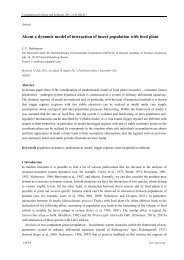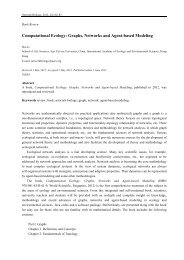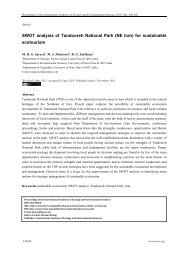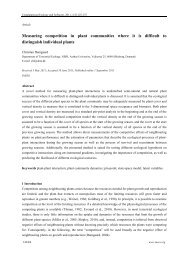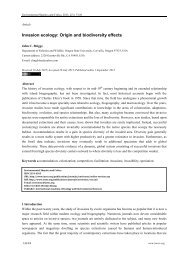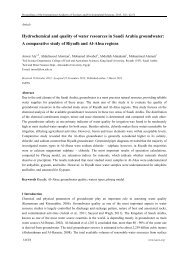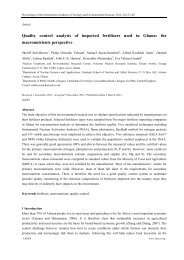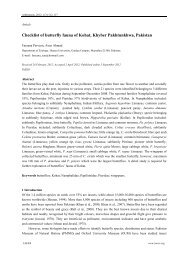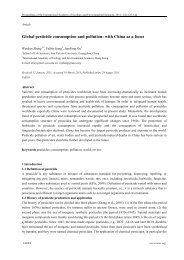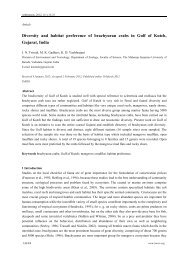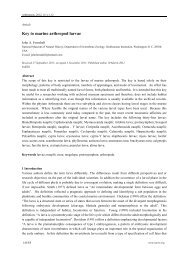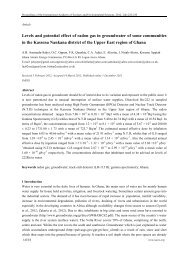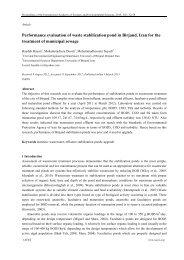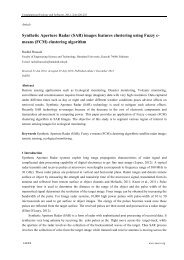Fish fauna of the Owabi Dam Reservoir in Ghana - International ...
Fish fauna of the Owabi Dam Reservoir in Ghana - International ...
Fish fauna of the Owabi Dam Reservoir in Ghana - International ...
You also want an ePaper? Increase the reach of your titles
YUMPU automatically turns print PDFs into web optimized ePapers that Google loves.
26<br />
Proceed<strong>in</strong>gs <strong>of</strong> <strong>the</strong> <strong>International</strong> Academy <strong>of</strong> Ecology and Environmental Sciences, 2012, 2(1):21-26<br />
4.4 <strong>Fish</strong>ery at <strong>Owabi</strong> <strong>Reservoir</strong><br />
<strong>Fish</strong><strong>in</strong>g practices at <strong>the</strong> study site were labor <strong>in</strong>tensive with m<strong>in</strong>imal mechanized assistance and total<br />
<strong>in</strong>vestments <strong>in</strong> fish<strong>in</strong>g equipment were generally low. This may have accounted for lower fish catch from <strong>the</strong><br />
reservoir. The catch is usually consumed locally especially by fisher folks and <strong>the</strong>ir family. The fishermen use<br />
dug-out boats made <strong>of</strong> wood and paddled. Personal conversations with some selected fishermen reiterated that<br />
catches were on <strong>the</strong> decl<strong>in</strong>e and this may be due to over-exploitation <strong>of</strong> <strong>the</strong> fish stocks. Decl<strong>in</strong>e <strong>in</strong> fish stock<br />
density may have accounted to <strong>the</strong> small scale nature <strong>of</strong> <strong>the</strong> fish<strong>in</strong>g activities at <strong>the</strong> site.<br />
5 Conclusions and Recommendations<br />
The <strong>Owabi</strong> <strong>Dam</strong> reservoir <strong>in</strong> <strong>Ghana</strong> is rich <strong>in</strong> fish diversity. Currently <strong>the</strong>re were about 19 fish species present.<br />
The reservoir exhibited a highly complex community structure for a larger array <strong>of</strong> species <strong>in</strong>teraction. Dur<strong>in</strong>g<br />
<strong>the</strong> study period, <strong>the</strong> species Hemichromis fasciatus was <strong>the</strong> most abundant with 45.1% and <strong>the</strong> least species<br />
was Hepsetus odoe with 0.7%. There was a reduction <strong>in</strong> <strong>the</strong> species diversity <strong>of</strong> <strong>the</strong> reservoir. This had been<br />
attributed to lower water levels, fish<strong>in</strong>g gear selectivity and fishes hid<strong>in</strong>g <strong>in</strong> <strong>the</strong> mangroves <strong>in</strong> <strong>the</strong> study area.<br />
<strong>Fish</strong>ery resources at <strong>the</strong> reservoir were be<strong>in</strong>g over-exploited and this was evidenced by low catches<br />
observed by fishermen dur<strong>in</strong>g <strong>the</strong> course <strong>of</strong> <strong>the</strong> study. There is <strong>the</strong> need for regulatory authorities such as <strong>the</strong><br />
<strong>Ghana</strong> Water Company Limited (GWCL) and <strong>the</strong> Wildlife Department (WD) <strong>of</strong>ficials to strictly enforce<br />
stricter fishery regulations at <strong>the</strong> site. This may help reduce over-exploitation <strong>of</strong> <strong>the</strong> fishery resource base at<br />
<strong>Owabi</strong> dam.<br />
References<br />
Amoah DC. 1988. Resource Identification and Zon<strong>in</strong>g <strong>of</strong> <strong>the</strong> <strong>Owabi</strong> wildlife Sanctuary (Unpublished Thesis).<br />
KNUST, Kumasi, <strong>Ghana</strong><br />
Food and Agriculture Organization (FAO). 1985. Feature poor fish<strong>in</strong>g communities. Rich harvest. Paper No.<br />
WFD/1/86. FAO, Rome, Italy<br />
Gall GAE. 1987 Inbreed<strong>in</strong>g. In: Population Genetics and <strong>Fish</strong>eries Management (Ryman N, Utter F, eds). 47-<br />
80, University <strong>of</strong> Wash<strong>in</strong>gton Press, Seattle, USA<br />
Holden M, Reed W. 1972. West African Freshwater <strong>Fish</strong>. Longman Publishers, New York, USA<br />
Karr JR. 1981. Assessment <strong>of</strong> biotic <strong>in</strong>tegrity us<strong>in</strong>g fish communities. <strong>Fish</strong>eries, 6: 21-27<br />
K<strong>in</strong>g M. 1995. <strong>Fish</strong>eries Biology, Assessment and Management. <strong>Fish</strong><strong>in</strong>g News Books, Oxford, UK<br />
Li S, Weimen L, Changdie P, et al. 1987. A genetic study <strong>of</strong> <strong>the</strong> growth performance <strong>of</strong> silver carp from<br />
Chiangjiang and Zhujiang rivers. Aquaculture, 65: 93-104<br />
Nelson K, Soule M. 1987. Genetical conservation <strong>of</strong> exploited fishes. In: Population Genetics and <strong>Fish</strong>eries<br />
Management (Ryman N, Utter F, eds). 345–368, University <strong>of</strong> Wash<strong>in</strong>gton Press, Seattle, USA<br />
Tiwari RN. 2011. Assessment <strong>of</strong> groundwater quality and pollution potential <strong>of</strong> Jawa Block Rewa District,<br />
Madhya Pradesh, India. Proceed<strong>in</strong>gs <strong>of</strong> <strong>the</strong> <strong>International</strong> Academy <strong>of</strong> Ecology and Environmental Sciences,<br />
1(3-4): 202-212<br />
Turner JL. 1977. Some effects <strong>of</strong> demersal trawl<strong>in</strong>g <strong>in</strong> Lake Malawi (Lake Nyasa) from 1968 to 1974. Journal<br />
<strong>of</strong> <strong>Fish</strong> Biology, 10: 261–71<br />
Zhang WJ, Jiang FB, Ou JF. 2011. Global pesticide consumption and pollution: with Ch<strong>in</strong>a as a focus.<br />
Proceed<strong>in</strong>gs <strong>of</strong> <strong>the</strong> <strong>International</strong> Academy <strong>of</strong> Ecology and Environmental Sciences, 1(2): 125-144<br />
IAEES<br />
www.iaees.org



